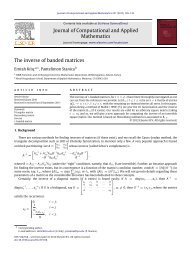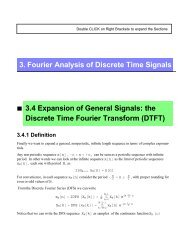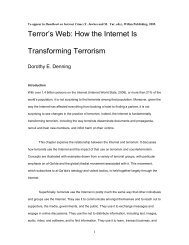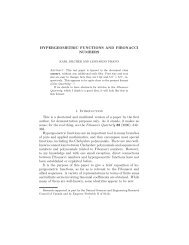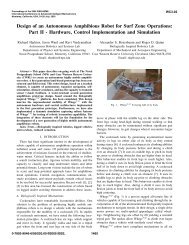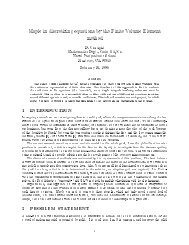Partial Solution Set, Leon §4.3 4.3.2 Let
Partial Solution Set, Leon §4.3 4.3.2 Let
Partial Solution Set, Leon §4.3 4.3.2 Let
Create successful ePaper yourself
Turn your PDF publications into a flip-book with our unique Google optimized e-Paper software.
(d) The coordinate vector of p(x) is (a0, a1, a2) T B<br />
with respect to the basis B given by<br />
[1, x, 1 + x2 ]. The nth power of L is given by the nth power of B, which is simple<br />
to compute because of the simple diagonal structure of B; Bn ⎡<br />
0 0 0<br />
= ⎣ 0 1 0<br />
0 0 2n ⎤<br />
⎦ . It<br />
follows that the coordinate vector for L n (p(x)) is B n (a0, a1, a2) T = (0, a1, 2 n a2), so<br />
L n (p(x)) = a1x + 2 n a2(1 + x 2 ).<br />
(e) There isn’t a part (e), but I would like to emphasis how this B = S−1AS helps:<br />
The coordinate vector of p(x) is (a0, a1, a2) T with respect to standard basis. The<br />
nth power of L is given by the nth power of A, which is not so simple to computer<br />
since A is not diagonal as it was in part (d). However, from B = S−1AS we can<br />
find A = SBS −1 , so then A2 = (SBS −1 ) 2 = SBS −1SBS −1 = SB2S −1 . Similarly,<br />
A100 = SB100S−1 , or generally An = SBnS −1 , for all natural numbers n. Thus<br />
⎡<br />
A n = ⎣<br />
1 0 1<br />
0 1 0<br />
0 0 1<br />
⎤ ⎡<br />
⎦ ⎣<br />
0 0 0<br />
0 1 0<br />
0 0 2 n<br />
⎤ ⎡<br />
⎦ ⎣<br />
1 0 1<br />
0 1 0<br />
0 0 1<br />
which is easy to computer as a product of three matrices, instead of multiplying A<br />
by itself n times. It follows that the coordinate vector for L n (p(x)) is A n (a0, a1, a2) T<br />
which is<br />
4.3.8 Suppose that A = SΛS −1 , where Λ is a diagonal matrix with main diagonal λ1, λ2, . . . , λn.<br />
(a) Show that Asi = λisi for each 1 ≤ i ≤ n.<br />
n�<br />
(b) Show that if x = αisi, then Ak n�<br />
x =<br />
i=1<br />
i=1<br />
αiλ k i si.<br />
(c) Suppose that |λi| < 1 for each 1 ≤ i ≤ n. What happens to A k x as k → ∞?<br />
<strong>Solution</strong>:<br />
(a) For any choice of i, 1 ≤ i ≤ n, we have<br />
Asi = � SΛS −1� =<br />
si<br />
SΛ � S −1 �<br />
si<br />
= SΛei<br />
= S (Λei)<br />
4<br />
= Sλiei<br />
= λiSei<br />
= λisi.<br />
⎤<br />
⎦<br />
−1<br />
,



